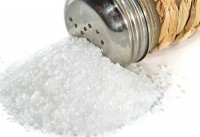Managing your salt intake is critical for cardiovascular and kidney health.
 Living in New Orleans, it can be difficult avoiding salt thanks to delicious dishes from fried seafood po-boys to rich crawfish étouffée. But chances are you’ve heard that salt is bad for you too — though that’s not the whole truth. Salt is a necessary part of the way your body functions, but salt becomes a problem when it’s consumed in excess.
Living in New Orleans, it can be difficult avoiding salt thanks to delicious dishes from fried seafood po-boys to rich crawfish étouffée. But chances are you’ve heard that salt is bad for you too — though that’s not the whole truth. Salt is a necessary part of the way your body functions, but salt becomes a problem when it’s consumed in excess.
Here’s what you need to know and a few tips to help you manage your salt intake.
What does salt do to the body?
Salt is an essential component to a healthy body because it helps to balance fluid and electrolytes. However, excess salt causes the body to retain fluids, and it also causes certain hormonal changes in the kidneys, which then leads to elevated blood pressure.
High blood pressure takes a toll on the heart and vasculature system (arteries and veins). Excess salt can harden the arteries and form blockages, which can lead to a heart attack, stroke or amputation depending on where the blockage is.
To avoid these complications, Thanh Nguyen, M.D., interventional cardiologist at Touro, recommends limiting salt intake to 2.3 grams (2,300 milligrams) per day for healthy individuals, and less than 2 grams (2,000 milligrams) per day for those with cardiovascular or kidney problems.
Who is at risk?
If you’ve had heart or kidney complications, your doctor may have already recommended limiting your salt intake. However, not everyone realizes they are at risk for cardiovascular disease, and therefore should be limiting their salt. Common risk factors include:
Family history of heart disease, particularly premature coronary artery disease in a first-degree relative
Hypertension
Diabetes
High cholesterol
Smoking
Tips to Shake the Salt Habit
Dr. Nguyen has several helpful tips to help you manage and cut back your salt intake when necessary.
Check the nutrition facts. The nutrition facts panel on any food includes the number of milligrams of sodium (salt) in the product. Keep track of the number of milligrams you consume per day for labeled foods, and look up the average sodium content for non-labeled foods. Get an idea of how much salt you’re ingesting and where you can cut back.
…But remember to count servings. Always check the serving size. Something may seem low in sodium per serving, but if you eat multiple servings’ worth, then you may consume more sodium than you realize.
Don’t be fooled by labels. “Low Sodium,” “Light Sodium,” “Very Low Sodium” — these labels run the gamut. However, the government doesn’t regulate these terms, so the words “low” or “light” could mean completely different things from one company to another. Make your choices based on the milligrams listed in the nutrition facts rather than marketing messages.
Go for fresh foods, not packaged or processed foods. Packaged, processed, canned and frozen foods are often high in sodium, because many companies use salt as a preservative. Even soda is often high in sodium, so stick to water.
Spice it up. Instead of using salt to add flavor, experiment with different spices, herbs or citrus. Spices not only bring vastly different flavors to the table, but they also often come with their own unique health benefits, such as cinnamon and turmeric.
…But avoid spice mixes. Everyone loves a heavy helping of Tony’s with their meal, but, if you’re looking to limit your salt, avoid Tony’s and similar salt-laden spice blends.
If indulging, be smart. Limiting your salt doesn’t mean you can never enjoy a salty snack or meal at a restaurant. Stay within your daily salt limit, and you can enjoy a salty treat or meal if you consume little to no salt the rest of the day.
If you have questions or concerns about salt or whether you are at risk for cardiovascular issues, speak with your doctor right away. Otherwise, start your salt management regimen at home with your own diet, and be mindful of your food choices going forward.
